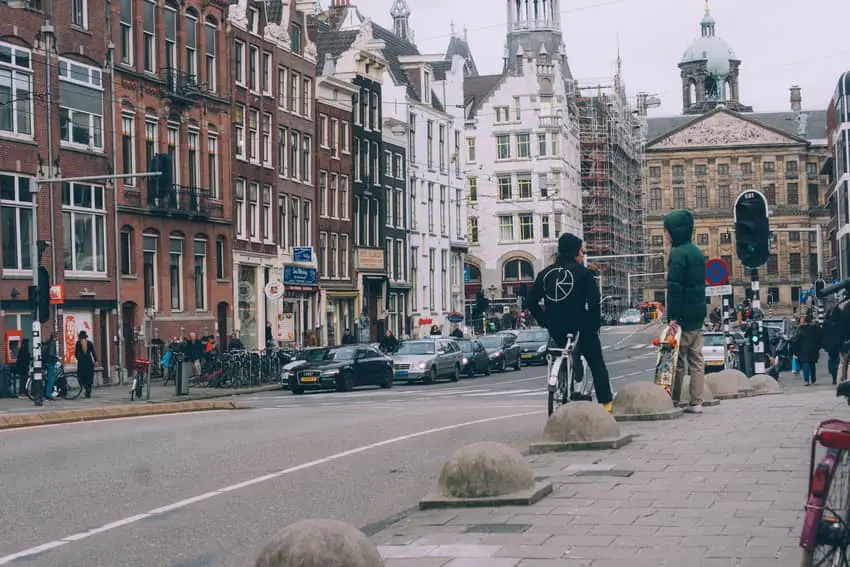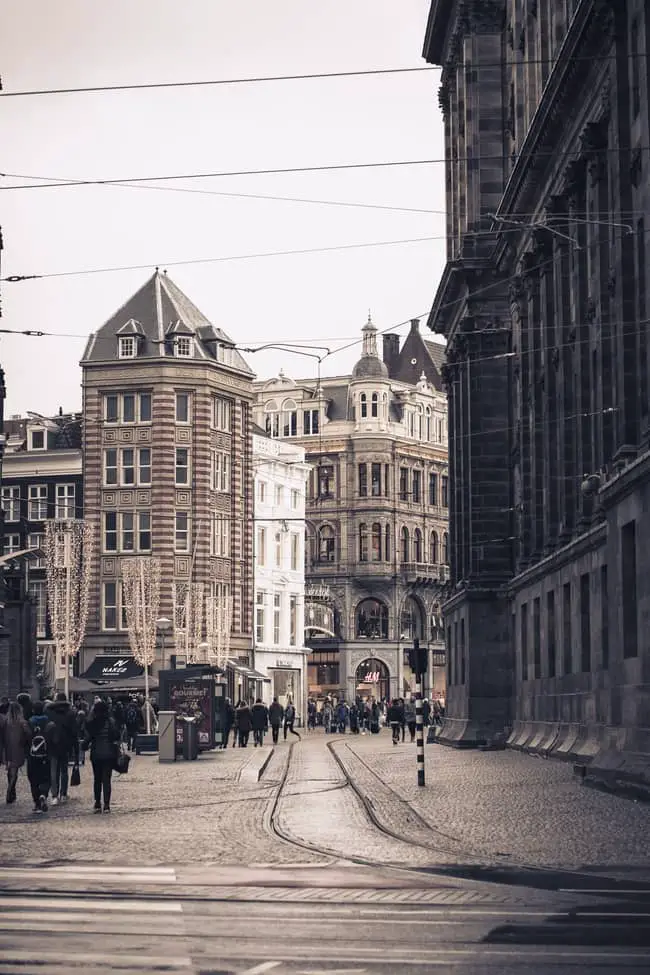The Royal Palace in Amsterdam is the official reception residence of the King of the Netherlands, Willem Alexander. It is also a building full of history where visitors can learn about the monarchy, the history of the Netherlands, art, architecture and more.
The Royal Palace is free for children until the age of 17. It is also free if you have a Museumkaart and there are also free audio tours available for everybody. However, the regular adult ticket costs 10 euros and the student and senior tickets cost 9 euros.

Amsterdam is a very interesting yet very expensive city. For most activities, you will have to pay, but let me tell you, they are all worth it. If you are visiting the capital of the Netherlands, it is impossible not to take note of the biggest building in the middle of Dam Square. If you are curious about this historic building and want to know more, this is your article!
Visit the Amsterdam Royal Palace
The entrance for the Royal Palace changes depending on the visitor, here there is a table with all the prices:
| TYPE OF VISITOR | PRICE |
| Adult | 10 euros |
| Adult with Museumkaart | free |
| Child (0-17) | free |
| Senior visitor (65+) | 9 euros |
| Student (Student card from any university) | 9 euros |
You can purchase the ticket in the Palace itself at the entrance or you can also skip any queue and buy them online on this website.
Moreover, with the purchase of your ticket, you will also get a free audio guide (in Dutch, English, Spanish, Italian, Russian, French, German and Chinese) and also a free one for children (available only in English and Dutch).
The Opening Hours vary depending on the national events, on regular days it is open from 10 am until 5 pm.
Group Visits
If you are planning to visit the Palace with a group, there are different terms applied:
- Tours during the week cost 95 euros in total. Each visitant pays for the ticket.
- Tours during the weekend cost 125 euros in total, plus the ticket of each visitor.
- Tours for school groups have the same prices but since it is free for children, these don’t have to pay for their tickets.
- There is one guide for every 10 visitors.
- You have to ask them to know what languages are available to plan your visit: here.
Free Museums in Amsterdam
As I was saying before, Amsterdam is a rather expensive city to visit. There are, however, some free options if you are travelling with a lower budget and don’t want to miss in all the history, architecture and so on.
Not so long ago I wrote an article about Free Museums in Amsterdam. These are some of the ideas I featured in the article:
- Light Festival (winter exhibition)
- Nieuwe Spiegelstraat (modern art and antique stores)
- Rijksmuseum Gardens (garden plus temporary exhibition)
- Multatuli Museum (Golden Ages History)
- Cultural Park
- Eye Fil Museum (free permanent exhibition plus amazing views)
- Diamond Tour
- ARCAM (Architecture arcade)
- …
Royal Palace Amsterdam
The Royal Palace of Amsterdam was constructed between 1648 and 1665, one of the main secular buildings of the 17th century not only in the Netherlands but in Europe. It was designed by Jacob van Campen following the style that we nowadays classify as Dutch Classicism.
As impressive as the exterior is, the real deal is inside: the interior is completely full of statues, sculptures and paintings symbolising the importance of justice, trade and the government.
History of the Royal Palace
The Royal Palace is a 17th-century building, a construction to commemorate the Dutch Golden Ages, the period of greatest growth for the Dutch culture. During this period there are a few improvements and additions to the country that inspired the construction of this building: majesty, trading, ships, discoveries and knowledge. During many years this building represented the biggest administrative building in Europe and it was nominated at the 8th Wonder of the World.

These inspirations are reflected in the building from the outside and the inside. These are some of the characteristics:
- It is a building with over 22,000 square meters
- The interior has marble floors on the halls
- There are two big maps on the floor representing the sky, the knowledge of navigation and science.
- On the roof of the palace, there is a cog ship-shaped. This is definitely a tribute to the explorers and tradesmen.
Another note we should add is the amazing pieces of art in the interior of the building, featuring art pieces made by the greatest artists of the Golden Ages, such as:
- Rembrandt van Rijn (Most Famous Dutch Golden Ages Painter)
- Ferdinand Bol (Dutch Painter of Portraits)
- Govert Flinck ( Dutch Painter-Portraits)
- Jacob Jardaens (Flemish History Painter)
It is important to point out that when this building was constructed, it became the Town Hall: during this period in history, the Netherlands was a Republic, formed by several provinces.
It wasn’t until the next century, at the end of the 80 Years War, that the Netherlands became a Monarchy, achieving the legal status it has today as a Democratic Monarchy with the Royal Family of the Orange-Nassau. It was then that the facade was decorated with a big statue of Peace, a woman holding a Branch of olive and a Rod of Asclepius as a representation of the Netherlands being a nation of peaceful trade people, trade and peace go hand by hand.
When did the Building become a Palace?
The first time this building became a Palace was during the decade between the first and the second monarch of the Orange-Nassau family. This monarch was Louis Napoleon, brother of Napoleon Bonaparte. Before, as I said, since it was a Republic and not a monarchy, it was a Town Hall.

Thanks to this change of function, the building became the new residence for future monarchs: from the 18th century onwards the building was the residence of the monarchy, considering that the best idea was to have the residence of the monarchs in the capital of the city.
Nowadays, King Willem-Alexander and his family live at Villa Eikenhorst in Wassenaar (north of The Hague). It is programmed for them to move to another one of the three official palaces that belong to the family, Huis ten Bosch Palace in the centre of The Hague. Nowadays this palace is used as the official place for receptions and meetings with presidents, other members of the Royal families, politicians, etc. The Royal Palace in Amsterdam is also used for some official receptions every now and then, but it is mostly open to the public as a museum.
When is the Royal Palace in Amsterdam Used?
The Royal Palace in Amsterdam is used only for State Visits.
A state visit is when the King invites another representative of a country or head of state from another country to visit the Netherlands. It is then when the palace is closed for the public and a big reception takes place in the luxurious palace.
During the first day of the visit, the activities during the day are focused on the army and the whole country witnesses the military honour guard on Dam Square. The King and his guest are present in the middle of the square too.
During the night of the first day, a state banquet takes place in the big Citizen’s Hall in the palace: a proper royal gala.
After these events that last not more than one day or two for the whole preparation, the palace is again open for the public to visit and the King and Queen show the rest of the country to the visitor. If you want to know more about it read the official website.
For History Lovers…
My recommendation for history lovers, for those visitors interested in the Royal Palace, those who are into history and who want to get to know more about the history of the country. I decided to create here a list of recommendations, like the ones I have given to my brother, who loves history, for those of you who share his passion:
- The Rijksmuseum: even though it can sound a tad cliche, the Rijksmuseum is a timeline of Dutch history from the beginning of this land until the current century. I have classified it and talked about it the Best Museum in Amsterdam.
- The Hermitage: this museum always have three different exhibitions going on, a foreign one, a modern one and the old Dutch Portraits. It is the later the one important for those of you interested in history. How the rest of Europe has still focused on religious art while in the Netherlands thanks to the wealth of trade, people were allowed to buy art and get themselves portraited for posterity.
- Walk: Amsterdam is expensive, yes, but some of the best parts of the city are outdoors, including the canals, the architecture and many other details one only gets to appreciate walking (even walking under the rain). Here is my guide on Amsterdam’s architecture.